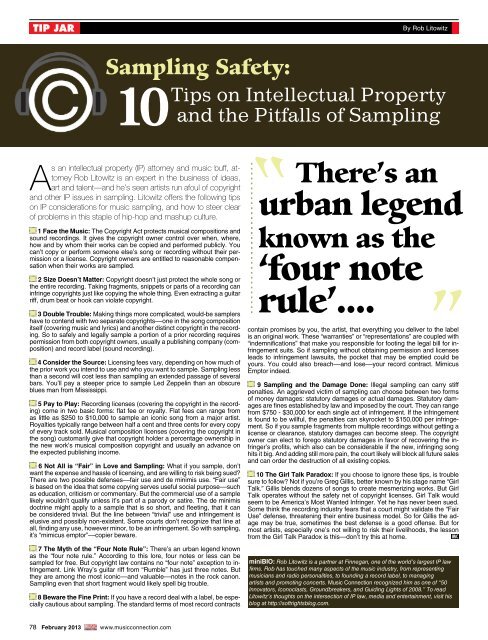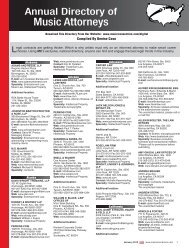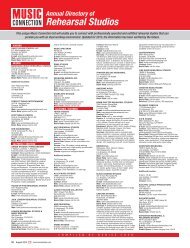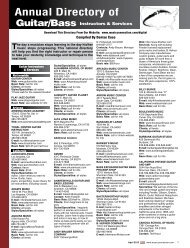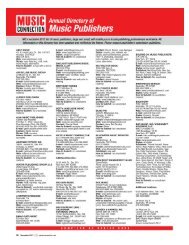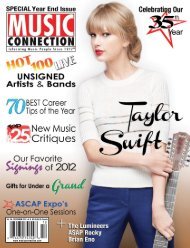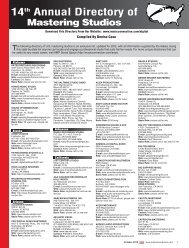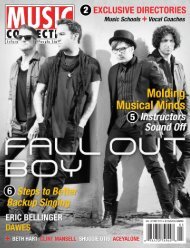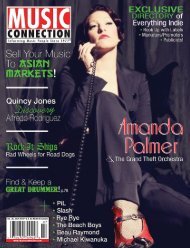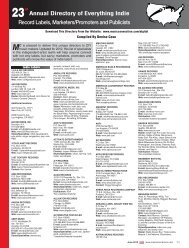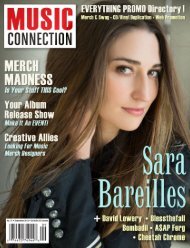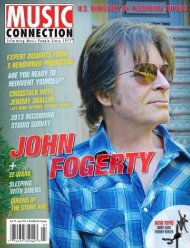www.musicconnection.com
February 2013 - Music Connection
February 2013 - Music Connection
- No tags were found...
Create successful ePaper yourself
Turn your PDF publications into a flip-book with our unique Google optimized e-Paper software.
TIP JAR<br />
By Rob Litowitz<br />
Sampling Safety:<br />
Tips on Intellectual Property<br />
10<br />
and the Pitfalls of Sampling<br />
As an intellectual property (IP) attorney and music buff, attorney<br />
Rob Litowitz is an expert in the business of ideas,<br />
art and talent––and he’s seen artists run afoul of copyright<br />
and other IP issues in sampling. Litowitz offers the following tips<br />
on IP considerations for music sampling, and how to steer clear<br />
of problems in this staple of hip-hop and mashup culture.<br />
1 Face the Music: The Copyright Act protects musical <strong>com</strong>positions and<br />
sound recordings. It gives the copyright owner control over when, where,<br />
how and by whom their works can be copied and performed publicly. You<br />
can’t copy or perform someone else’s song or recording without their permission<br />
or a license. Copyright owners are entitled to reasonable <strong>com</strong>pensation<br />
when their works are sampled.<br />
2 Size Doesn’t Matter: Copyright doesn’t just protect the whole song or<br />
the entire recording. Taking fragments, snippets or parts of a recording can<br />
infringe copyrights just like copying the whole thing. Even extracting a guitar<br />
riff, drum beat or hook can violate copyright.<br />
3 Double Trouble: Making things more <strong>com</strong>plicated, would-be samplers<br />
have to contend with two separate copyrights––one in the song <strong>com</strong>position<br />
itself (covering music and lyrics) and another distinct copyright in the recording.<br />
So to safely and legally sample a portion of a prior recording requires<br />
permission from both copyright owners, usually a publishing <strong>com</strong>pany (<strong>com</strong>position)<br />
and record label (sound recording).<br />
4 Consider the Source: Licensing fees vary, depending on how much of<br />
the prior work you intend to use and who you want to sample. Sampling less<br />
than a second will cost less than sampling an extended passage of several<br />
bars. You’ll pay a steeper price to sample Led Zeppelin than an obscure<br />
blues man from Mississippi.<br />
5 Pay to Play: Recording licenses (covering the copyright in the recording)<br />
<strong>com</strong>e in two basic forms: flat fee or royalty. Flat fees can range from<br />
as little as $250 to $10,000 to sample an iconic song from a major artist.<br />
Royalties typically range between half a cent and three cents for every copy<br />
of every track sold. Musical <strong>com</strong>position licenses (covering the copyright in<br />
the song) customarily give that copyright holder a percentage ownership in<br />
the new work’s musical <strong>com</strong>position copyright and usually an advance on<br />
the expected publishing in<strong>com</strong>e.<br />
6 Not All is “Fair” in Love and Sampling: What if you sample, don’t<br />
want the expense and hassle of licensing, and are willing to risk being sued?<br />
There are two possible defenses––fair use and de minimis use. “Fair use”<br />
is based on the idea that some copying serves useful social purpose––such<br />
as education, criticism or <strong>com</strong>mentary. But the <strong>com</strong>mercial use of a sample<br />
likely wouldn’t qualify unless it’s part of a parody or satire. The de minimis<br />
doctrine might apply to a sample that is so short, and fleeting, that it can<br />
be considered trivial. But the line between “trivial” use and infringement is<br />
elusive and possibly non-existent. Some courts don’t recognize that line at<br />
all, finding any use, however minor, to be an infringement. So with sampling,<br />
it’s “mimicus emptor”––copier beware.<br />
7 The Myth of the “Four Note Rule”: There’s an urban legend known<br />
as the “four note rule.” According to this lore, four notes or less can be<br />
sampled for free. But copyright law contains no “four note” exception to infringement.<br />
Link Wray’s guitar riff from “Rumble” has just three notes. But<br />
they are among the most iconic––and valuable––notes in the rock canon.<br />
Sampling even that short fragment would likely spell big trouble.<br />
8 Beware the Fine Print: If you have a record deal with a label, be especially<br />
cautious about sampling. The standard terms of most record contracts<br />
There’s an<br />
urban legend<br />
known as the<br />
‘four note<br />
rule’....<br />
“<br />
“<br />
contain promises by you, the artist, that everything you deliver to the label<br />
is an original work. These “warranties” or “representations” are coupled with<br />
“indemnifications” that make you responsible for footing the legal bill for infringement<br />
suits. So if sampling without obtaining permission and licenses<br />
leads to infringement lawsuits, the pocket that may be emptied could be<br />
yours. You could also breach––and lose––your record contract. Mimicus<br />
Emptor indeed.<br />
9 Sampling and the Damage Done: Illegal sampling can carry stiff<br />
penalties. An aggrieved victim of sampling can choose between two forms<br />
of money damages: statutory damages or actual damages. Statutory damages<br />
are fines established by law and imposed by the court. They can range<br />
from $750 - $30,000 for each single act of infringement. If the infringement<br />
is found to be willful, the penalties can skyrocket to $150,000 per infringement.<br />
So if you sample fragments from multiple recordings without getting a<br />
license or clearance, statutory damages can be<strong>com</strong>e steep. The copyright<br />
owner can elect to forego statutory damages in favor of recovering the infringer’s<br />
profits, which also can be considerable if the new, infringing song<br />
hits it big. And adding still more pain, the court likely will block all future sales<br />
and can order the destruction of all existing copies.<br />
10 The Girl Talk Paradox: If you choose to ignore these tips, is trouble<br />
sure to follow? Not if you’re Greg Gillis, better known by his stage name “Girl<br />
Talk.” Gillis blends dozens of songs to create mesmerizing works. But Girl<br />
Talk operates without the safety net of copyright licenses. Girl Talk would<br />
seem to be America’s Most Wanted Infringer. Yet he has never been sued.<br />
Some think the recording industry fears that a court might validate the “Fair<br />
Use” defense, threatening their entire business model. So for Gillis the adage<br />
may be true, sometimes the best defense is a good offense. But for<br />
most artists, especially one’s not willing to risk their livelihoods, the lesson<br />
from the Girl Talk Paradox is this—don’t try this at home.<br />
miniBIO: Rob Litowitz is a partner at Finnegan, one of the world’s largest IP law<br />
firms. Rob has touched many aspects of the music industry, from representing<br />
musicians and radio personalities, to founding a record label, to managing<br />
artists and promoting concerts. Music Connection recognized him as one of “50<br />
Innovators, Iconoclasts, Groundbreakers, and Guiding Lights of 2008.” To read<br />
Litowitz’s thoughts on the intersection of IP law, media and entertainment, visit his<br />
blog at http://softrightsblog.<strong>com</strong>.<br />
78 February 2013 <strong>www</strong>.<strong>musicconnection</strong>.<strong>com</strong>


